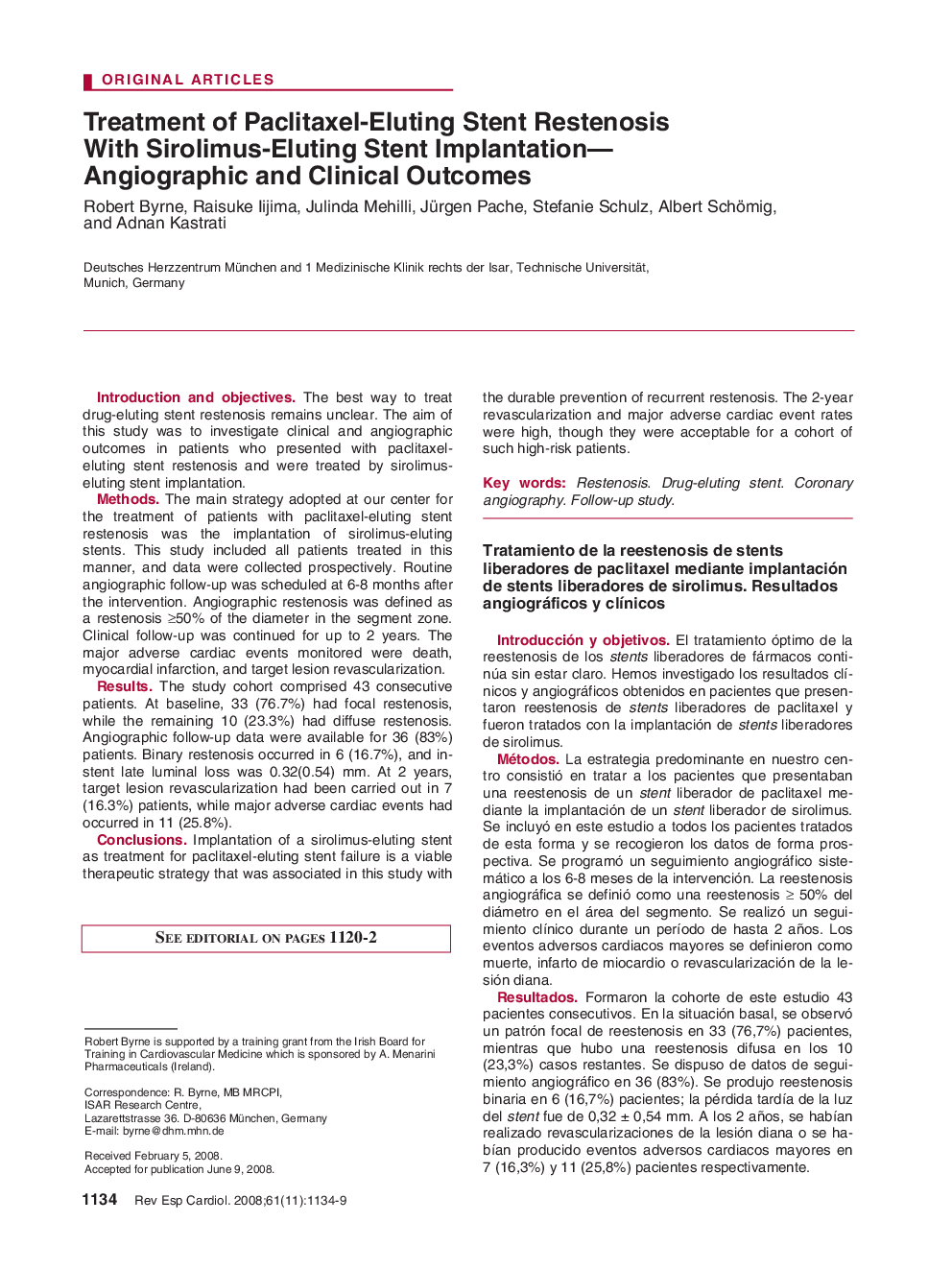| Article ID | Journal | Published Year | Pages | File Type |
|---|---|---|---|---|
| 3018634 | Revista Española de Cardiología (English Edition) | 2008 | 6 Pages |
Introduction and objectivesThe best way to treat drug-eluting stent restenosis remains unclear. The aim of this study was to investigate clinical and angiographic outcomes in patients who presented with paclitaxeleluting stent restenosis and were treated by sirolimuseluting stent implantation.MethodsThe main strategy adopted at our center for the treatment of patients with paclitaxel-eluting stent restenosis was the implantation of sirolimus-eluting stents. This study included all patients treated in this manner, and data were collected prospectively. Routine angiographic follow-up was scheduled at 6–8 months after the intervention. Angiographic restenosis was defined as a restenosis ≥50% of the diameter in the segment zone. Clinical follow-up was continued for up to 2 years. The major adverse cardiac events monitored were death, myocardial infarction, and target lesion revascularization.ResultsThe study cohort comprised 43 consecutive patients. At baseline, 33 (76.7%) had focal restenosis, while the remaining 10 (23.3%) had diffuse restenosis. Angiographic follow-up data were available for 36 (83%) patients. Binary restenosis occurred in 6 (16.7%), and instent late luminal loss was 0.32(0.54) mm. At 2 years, target lesion revascularization had been carried out in 7 (16.3%) patients, while major adverse cardiac events had occurred in 11 (25.8%).ConclusionsImplantation of a sirolimus-eluting stent as treatment for paclitaxel-eluting stent failure is a viable therapeutic strategy that was associated in this study with the durable prevention of recurrent restenosis. The 2-year revascularization and major adverse cardiac event rates were high, though they were acceptable for a cohort of such high-risk patients.
Introducción y objetivosEl tratamiento óptimo de la reestenosis de los stents liberadores de fármacos continúa sin estar claro. Hemos investigado los resultados clínicos y angiográficos obtenidos en pacientes que presentaron reestenosis de stents liberadores de paclitaxel y fueron tratados con la implantación de stents liberadores de sirolimus.MétodosLa estrategia predominante en nuestro centro consistió en tratar a los pacientes que presentaban una reestenosis de un stent liberador de paclitaxel mediante la implantación de un stent liberador de sirolimus. Se incluyó en este estudio a todos los pacientes tratados de esta forma y se recogieron los datos de forma prospectiva. Se programó un seguimiento angiográfico sistemático a los 6–8 meses de la intervención. La reestenosis angiográfica se definió como una reestenosis ≥ 50% del diámetro en el área del segmento. Se realizó un seguimiento clínico durante un período de hasta 2 años. Los eventos adversos cardiacos mayores se definieron como muerte, infarto de miocardio o revascularización de la lesión diana.ResultadosFormaron la cohorte de este estudio 43 pacientes consecutivos. En la situación basal, se observó un patrón focal de reestenosis en 33 (76,7%) pacientes, mientras que hubo una reestenosis difusa en los 10 (23,3%) casos restantes. Se dispuso de datos de seguimiento angiográfico en 36 (83%). Se produjo reestenosis binaria en 6 (16,7%) pacientes; la pérdida tardía de la luz del stentfue de 0,32 ± 0,54 mm. A los 2 años, se habían realizado revascularizaciones de la lesión diana o se habían producido eventos adversos cardiacos mayores en 7 (16,3%) y 11 (25,8%) pacientes respectivamente.ConclusionesLa implantación de stents liberadores de sirolimus como tratamiento del fallo de los stents liberadores de paclitaxel es una estrategia terapéutica factible que se relaciona con una prevención duradera de la reestenosis recurrente. A 2 años, las tasas de revascularización y de eventos adversos cardiacos mayores son significativas aunque aceptables en una cohorte de pacientes de alto riesgo.
